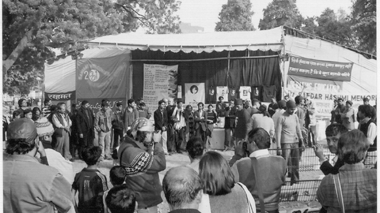 People's Democracy
People's Democracy
(Weekly
Organ of the Communist Party of India (Marxist)
No. 02
January 08, 2006
(Weekly
Organ of the Communist Party of India (Marxist)
|
Vol.
XXX
No. 02 January 08, 2006 |
Saluting The Memory Of Comrade Safdar Hashmi

A street play in progress at the 17th Safdar Memorial organised by Sahmat
Suhail Hashmi
The Vitthalbhai Patel House Grounds were the venue for the 17th Safdar Hashmi Memorial on the first day of 2006. The first of January in Delhi is usually a bitterly cold and gloomy day, usually marked with thick fog, bone-piercing cold winds and occassionally with rain. This first of January was warm and bright and by the time Act One began to perform their street play there was bright sunshine and the sizeable gathering came around to watch the performance.
For the last 17 years all the Safdar Memorial programmes have begun with a Street Play, a reminder of the attack on Jan Natya Manch, on the chilly January 1, 1989 that led to the death of Safdar and the birth, a month later, of SAHMAT - the Safdar Hashmi Memorial Trust - a movement in defence of creative expression and freedom of speech.
The January 1 Sahmat concerts have grown into an event that artists, writers, musicians, theatre workers, cultural and social activists, intellectuals, young film makers, students and many others have made into their own.
This year the January 1, programme, that began at 3.00 pm to continue non stop till past midnight, included performances from a galaxy of well known artists who have been regulars with Sahmat. There were also some extremely talented young artists, participating in the programme for the first time, who would have been little children or at best in their early teens when the 1st Safdar Hashmi Memorial was organised in 1990.
The year 2006 marks the 75th anniversary of the Dandi Yatra and Sahmat has chosen the theme of the Yatra for a series of activities planned for the year. The first of these was the release of a calendar designed around 12 works of art on the theme of the Salt Satyagrah. Twelve of the finest artists of the country including Amit Ambalal, Jatin Das, Jehangir Sabavala, K G Subramaniyan, Nilima Sheikh, Haku Shah, Arpana Kaur, Jogen Chowdhury, Atul Dodiya, Orijit Sen, Vivan Sundaram and Subha De have produced one work each on the theme that have been brought together in the 2006 calender brought out by Sahmat.
The significance of the satyagrah was brought out in the specially designed performance by Astad Debu that set the tone for the nine-hour long programme.
The historical significance of the March, foregrounded by Professor Mridula Mahajan, in her intervention, was echoed in the performances of several artists, including Vidya Shah, Mehmood Dhaulpuri and Fakhur-ud-din Dhaulpuri among others, who touched upon the inclusive nature of the movement and of the persona of Gandhi who lived and died for an inclusive and tolerant India. Sufi and Bhakti music, representing the strong traditions of tolerance and suleh kul, that have been instrumental in shaping the spiritual makeup of the people of India and were the mainstay of the Gandhian discourse, were a constant presence in the performances of among others the Dhrupad maestros, Ramakant and Umakant Gundecha, Sunanda Sharma, Mita Pandit, Jabir Jassi and others.
Overshadowing all this, however, was the presence of the youth. This 17th Memorial to Safdar marked a definitive shift towards youth. This was probably the most heartening aspect of the event that has carved for itself a definite space on the cultural calendar of Delhi. The stage, the Gandhi slide show on two huge screens and the lighting was designed by two young men – One an architect and the other a film maker, who were not even in their teens when Safdar was murdered. At least three of the artists Fakhur-ud-din Dhau-lpuri, Aditi Sharma and Mandakini Banerjee were mere toddlers when Sahmat was formed. The two exhibitions mounted on the occasion and the colourful display of Sahmat banners was executed by a young artist who did his graduation just a couple of years ago.
This participation of the youth was not confined to a handful of individuals, who designed the stage or performed on it. It was evidenced in the audience as well, there was a much lager proportion of youth and students in the day long programme. In fact, there were almost a hundred young men and women – students, street theatre activists, social workers and others who had travelled from Rohtak, Jind, Sirsa and other places in Haryana to be a part of the audience.
This gradual involvement of a new generation, that did not know Safdar and was not witness to the events that shaped Safdar and the formation of Sahmat, has been a process that has been in the making for some years now. The increasing involvement of a new generation as performers, programme organisers and members of the audience is proof, if proof be needed, of the vitality and relevance of the work that Sahmat initiated almost two decades ago.